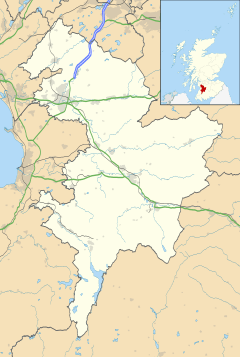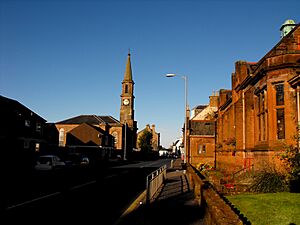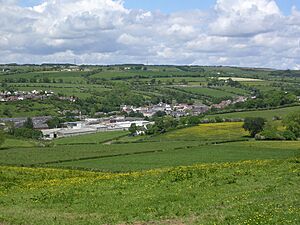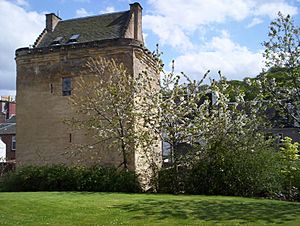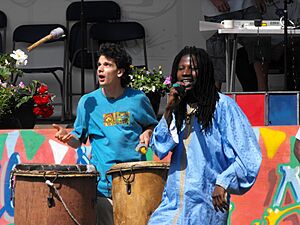Newmilns facts for kids
Quick facts for kids Newmilns |
|
|---|---|
| Burgh (Newmilns and Greenholm) and Village | |
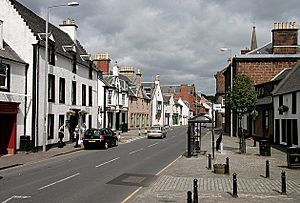 The main street in Newmilns, 2010 |
|
| Population | 2,720 (2020) |
| Language | English |
| OS grid reference | NS533372 |
| Council area | |
| Lieutenancy area |
|
| Country | Scotland |
| Sovereign state | United Kingdom |
| Post town | Newmilns |
| Postcode district | KA16 |
| Dialling code | 01560 |
| Police | Strathclyde |
| Fire | Strathclyde |
| Ambulance | Scottish |
| EU Parliament | Scotland |
| UK Parliament |
|
| Scottish Parliament |
|
Newmilns is a village in the area of Newmilns and Greenholm, located in East Ayrshire, Scotland. It's home to over 3,000 people and sits on the A71 road. You can find it about seven miles east of Kilmarnock and twenty-five miles southwest of Glasgow. The village is nestled in a valley with the River Irvine flowing through it. Along with nearby towns like Darvel and Galston, it forms a region called the Upper Irvine Valley, or "The Valley" by locals.
The name "Newmilns and Greenholm" shows that the area has two main parts: Newmilns north of the river and Greenholm to the south. The river also separates the old areas of Loudoun and Galston. This is why the village, often just called Newmilns, still uses both names.
Contents
What's in a Name?
The name Newmilns comes from old English words: niwe (new) and mylen (mill). So, it means "new mill." This suggests the name has been around since the Old English period, from the mid-400s to the mid-1100s. The earliest time the name was written down was in 1126 as Nawemeln. The "s" at the end, making it plural, appeared by the 1400s.
Not many of the old mills are left today. The last one working was Pate's Mill, which was taken down in 1977. Only a small part of its outer wall remains. The only mill building still standing is Loudoun Mill, now used as homes. It was a working mill from 1593 until the 1960s.
A Look Back in Time
Early Days of Newmilns
People have lived in The Valley for a very long time. The oldest signs of life date back to about 2000 BC. For example, a Neolithic stone circle was found east of Loudoun Gowf Course. A Bronze Age burial mound from about 1000 BC was also discovered.
Around AD 200, there's proof of a Roman camp at Loudoun Hill. A Roman road also ran through The Valley to the coast at Ayr. Sadly, much of this evidence was lost during quarry work. Local workers said many old items were used in road building projects.
Not much is known about The Valley's history during the Dark Ages. But it's thought an important battle happened around AD 575 at the Glen Water. Newmilns was a key crossing point and a busy trade route. So, it's likely other battles took place here too.
From AD 800 to 1200, there were many forts and earthworks in the area. These were likely built because Vikings were present in the region.
Becoming a Burgh
Newmilns became a special type of town called a free Burgh of Barony on January 9, 1490. This was a gift from King James IV to George Campbell of Loudoun and the people of Newmilns. This was a big step for Newmilns. It meant the town could control its own economy. It could also choose its own local leaders and hold weekly markets and yearly fairs.
Newmilns is the oldest inland burgh in Ayrshire. It became a Burgh of Regality in 1707. Later, it became a Police Burgh in 1834. The people of Newmilns see the granting of burgh status as the start of their town. This is why they celebrated its 500th birthday in 1990.
Faith and Freedom
The first known Christian worship in the area was at Loudoun Kirk, built around 1451. As Newmilns grew, a new church was built in 1530. This became the main church after 1600. Today, Loudoun Church is the main place of worship in Newmilns.
Around 1520, a local farmer named Murdoch Nisbet created the first Scots Language version of the New Testament. At that time, it was against the law for ordinary people to own a Bible. The punishment could be jail or even death. Because of this, Nisbet had to leave the country. Luckily, he was able to return later. His Bible was passed down through his family for generations. It is now kept at the British Museum. In 2003, a new housing area was named Murdoch Nisbet Court in his honor.
The next century brought more religious changes. In 1638, all men had to sign the National Covenant. This put them at risk of religious persecution. On June 1, 1679, a large gathering of Covenanters near Loudoun Hill was attacked by soldiers. This fight became known as the Battle of Drumclog. The Covenanters won against the soldiers. Murdoch Nisbet's great-grandson, John Nisbet, was there. Two Newmilns residents, John Gebbie and John Morton, died in the battle. Many other Newmilns people were likely there too.
Newmilns remembers several other Covenanter martyrs. A stone at Loudoun Church lists names like Matthew Paton and David Findlay. These brave people stood up for their beliefs. A plaque in Castle Street also remembers John Law. He helped eight Covenanters escape from Newmilns Keep in 1685.
Weaving, Lace, and Factories
In the late 1500s, people called Huguenot refugees came to the area. They taught Newmilns the skill of weaving. About 200 years later, Britain started getting cotton from the United States. Newmilns already had a strong weaving tradition. So, the town's handloom industry became very important across the country. The town grew from about 500 people in 1750 to 2,000 in 1850. Newmilns became very successful during this time.
Joseph Hood, born in Newmilns in 1821, became a key figure in the lace industry. He invented many new weaving machines. But handloom weaving was fading. New machines like the power loom in 1877 meant many weavers lost their jobs. This caused the population to drop as people left to find work.
In 1876, Joseph Hood and Hugh Morton brought a lace curtain machine to Newmilns. Soon, more companies followed. Within ten years, eight more companies started. They provided jobs for over 1,500 people.
The success of the lace industry made Newmilns grow quickly. New areas like Loudoun Road and Darvel Road saw many new homes built. Council housing was also built in the 1900s. However, the lace industry began to decline in the 20th century. Wars and economic problems led to fewer markets and raw materials. Today, only two lace mills are still working.
Newmilns Today
Newmilns has seen a big drop in jobs. The lace industry declined, and many factories and businesses closed. This includes the Vesuvius plant and the railway station. Many local shops also closed because fewer people were working in town.
Newmilns has changed from a factory town to a commuter town. This means more people travel outside Newmilns for work. The population has also dropped from 5,000 before the wars to just over 3,000 today.
Nature Around Newmilns
The Landscape
Newmilns is in a glaciated valley. It is mostly surrounded by farmland and woodland. The Lanfine Estate, south of town, is very interesting. It became owned by the Brown family in 1769. They made many improvements, like planting lots of trees, creating Lanfine Wood. They also built a large house and three gatehouses. Browns Road was built to connect Newmilns to Darvel and access the estate.
In the 1990s, wild boar were introduced to the estate. Today, both Browns Road and Lanfine are popular places for walks.
Town Buildings
Newmilns stretches for about two miles along the narrowest part of The Valley. It generally follows the river. Most of the town is on the north side of the river. Newer buildings appear as you move from The Cross to the edge of town. Some old factory buildings have been turned into new homes, but they still keep their original look.
The most important buildings are around The Cross. The townhouse was built in 1739. It shows how rich Newmilns was during the handloom weaving period. The town bell, in the belltower, has the date 1547 on it, which is older than the building itself. The Browns Institute, given by Ms Martha Brown in 1872, is also here.
The Keep, also called Newmilns Tower, is the oldest building in Newmilns. It dates back to the 1530s. Over time, The Keep has been a barracks, a prison, and even a beer cellar. It was fixed up in 1997 and is now used as homes.
Lamlash House, built in 1888-1889, is another important building. It has five beautiful stained glass windows. These windows show famous Scottish poets like Robert Burns. The house is now used for private events.
Local Wildlife
Newmilns has a mix of farms, woods, town areas, and fresh water. This means it's home to many different kinds of wildlife. It has a healthy red squirrel population, which is rare in other parts of the country. You can also find badgers, foxes, deer, rabbits, and hedgehogs.
The river is home to minnows, salmon, and trout. You might also see frogs, toads, and many insects. Common kingfishers have been spotted along the riverbank.
Newmilns also has many birds. The Eurasian jackdaw is very common. You can also see carrion crows, rooks, common swifts, and barn swallows. Other birds include robins, common starlings, and Eurasian magpies. Grey herons are often seen by the river. Common kestrels are found west of town. Owls, like tawny and barn owls, also live here, though their numbers have dropped.
Lammas Floods
Newmilns has experienced severe floods, sometimes called the Lammas Floods. These usually happen around August. On October 18, 1954, heavy rain washed a town dump downhill. This caused a "black tide" of dirt and debris to flood homes and businesses.
Many people remembered the flood of August 10, 1920. Heavy rain caused the river to overflow. It damaged the Main Street and Kilnholm Street. The force of the river even made a stone wall collapse.
Since 1954, better planning and building methods have helped reduce the impact of these floods. However, in 2007 and 2008, heavy rain again caused burns north of town to overflow. This led to more damage to homes and businesses.
Fun Things to Do
Popular Activities
Newmilns has many clubs and groups for different ages and interests. There's a bowling club, a dry ski slope, and a mountain-bike track. You can also find three public houses, an annual cattle show, a library, and three public parks. Jamieson Park is home to the local football team, Newmilns Vesuvius AFC. In 2022, a new team, Newmilns Greenholm AFC, was started by locals.
Irvine Valley Walking Festival
The Irvine Valley Walking Festival started in 2003. It's now an annual event that has grown bigger each year. The festival uses the Irvine Valley Paths Network, which connects about 35 miles of old railway lines and country roads. Walkers usually have guides who share facts about local places.
Gala Day Fun
Like many towns, Newmilns has an annual gala day. The day begins with a brass band-led parade. Local groups, businesses, and community members join in. The parade starts at Gilfoot and goes through the town.
The main event lasts all afternoon. It features bands, races, stalls, and fun games like tug-o-war. The day ends with the crowning of the gala queen. The gala day is an important event that brings the whole community together.
Cool Facts About Newmilns
The Age of Steam
The Vesuvius site today was once a railway station. It opened in 1850 and was busy until the 1930s. Then, people started using buses more. After that, the railway mainly carried goods and mail. Newmilns' railway service was closed in the 1960s.
The area behind Newmilns Fire Station used to be Loudoun Colliery, a coal mine. A special track carried coal from the mine to the main railway. You can't see the track now, but a hump in the road marks where it crossed.
Fighting for Freedom
During the American Civil War, the Newmilns Anti-Slavery Society was formed. They wrote to the U.S. Government to show their support against slavery. Abraham Lincoln was thankful and gave Newmilns an American flag. The original flag was lost, but a new one was given in 1949.
The Battle of the Lime Road
The Lime Road, on the west side of Newmilns, was once a popular walking path. From 1878 to 1893, Baron Donington tried to block access to walkers. Local residents took him to court and won. This protected the Lime Road as a public path.
Robert Burns' Visits
In 1786, the famous poet Robert Burns planned to leave Scotland for Jamaica. He was not well-known then. But a letter from another poet, Thomas Blacklock, convinced him to stay and publish more work. This letter arrived just days before Burns was due to leave. It also saved his life, as the ship he would have taken sank. Blacklock had learned about Burns from Rev. George Lawrie of Loudoun Manse.
Lawrie welcomed Burns to the manse several times. Burns' brother wrote that it was a "delightful family scene" for the poet. Burns even scratched a line on a window pane with his diamond: "Lovely Mrs. Lawrie, she is all charms."
Football History
Around the early 1900s, many local footballers became successful in Scottish and English leagues. One of the most remembered is Hughie Wilson. In 1890, he played for Scotland against Wales while playing for Newmilns Seniors. He went on to win three English league titles with Sunderland. Later, he won the league and cup with Third Lanark in Scotland.
In 1891, a Newmilns lace company opened a factory in Gothenburg, Sweden. Newmilns employees went there to set it up. While in Gothenburg, these employees started a football team called Örgryte Idrottsällskap. They won Sweden's first ever football match. These employees also helped form another team that later became the famous IFK Göteborg.
Two years later, the company opened a factory in Barcelona, Spain. Again, Newmilns workers went there. They started another football team, Colonia Escocesa. Local historians say this team played in the first ever Spanish cup final. Records show that in 1900, Colonia Escocesa lost 2–0 to FC Barcelona in a friendly match. It's possible the players saw it as a big international game.
At least one Newmilns man, George Girvan, played for FC Barcelona before returning to Scotland. It's likely he and other Newmilns residents won trophies with the club.
Golfing History
Loudoun Gowf Club's land was rented from the Earl of Loudoun in 1908. The deal said that if the club closed, the land had to be returned to its original state. The club often struggled financially. It's believed it only survived because it never had enough money to restore the land until 1947!
Street Names Over Time
Many street names in Newmilns have changed. High Street used to be three parts: Doitburn Street, Grey Street, and High Street. Nelson Street was also divided into North Devon Place, Waterwynd, and Nelson Street. The area of Main Street around the Brigend was called West Strand. Castle Street was once New Road.
One area of Greenholm, Stewarts Place, has almost disappeared. It was built for workers who extended the railway line. Stewarts Place became known as Bedlam because it fell into disrepair. Some parts of the buildings are still there, but they are hidden behind a stone wall.
Gilfoot was built from 1936 to 1939. It was planned to have electric street lighting. But at first, the lights weren't connected to electricity. So, gas lights were hung on the lamp-posts. This sight made the area feel like a place in the East. Locals started calling Gilfoot Shanghai. This name was used for many years, even after the gas lights were removed.
See also
- Castle and Lands of Auchruglen – A Nesbitt and Campbell keep located near the Auchruglin Glen at Crosstree Farm.


